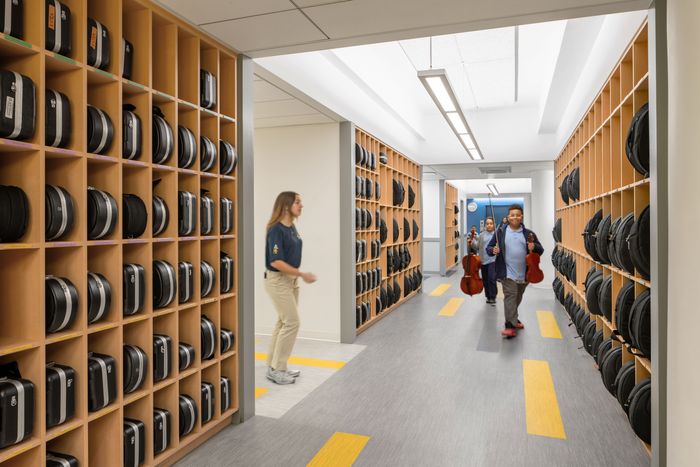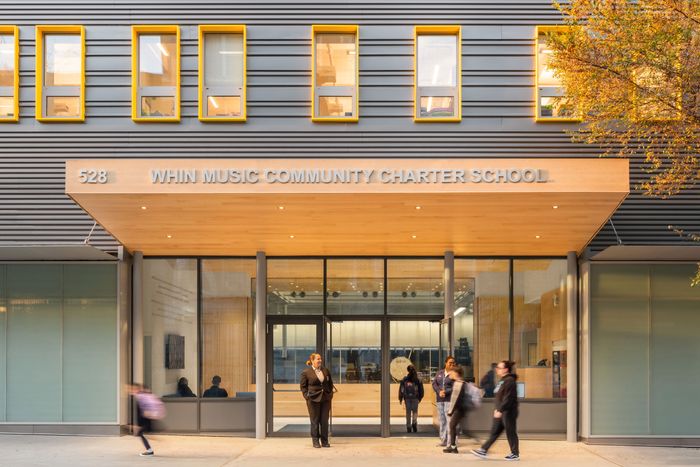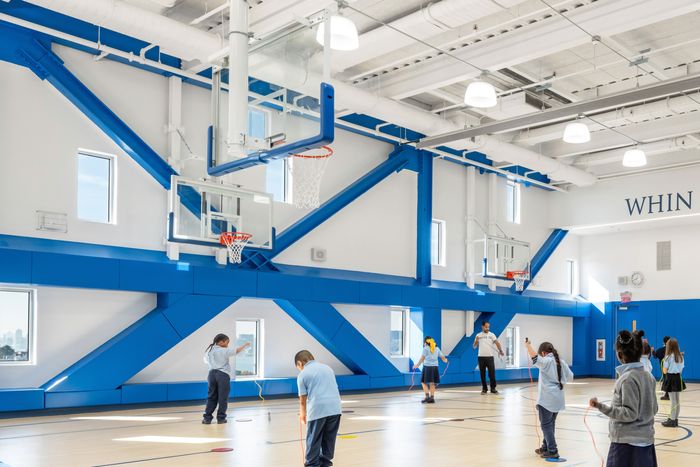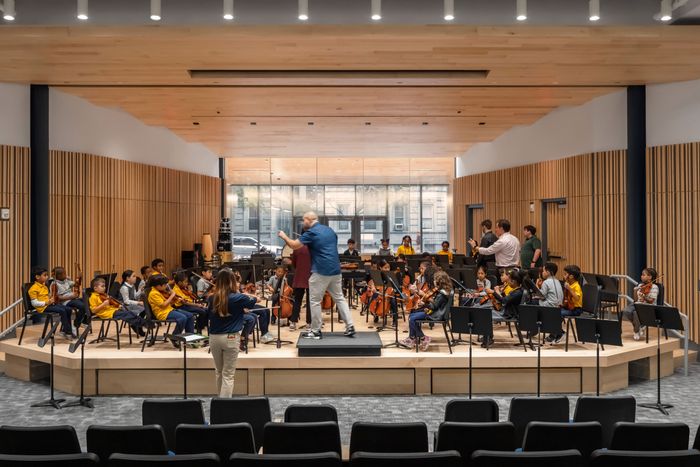Gluck+’s Washington Heights–Inwood Music Community Charter School.
Photo: Courtesy of GLUCK+
Being demoralized about the state of architecture is like sitting in a beanbag chair: It’s an easy position to slump into and a struggle to get out of. A decade ago, the architect Reinier de Graaf published an essay that seethed with dismay. He wrote that in the 20th century, modernists, driven by utopian cravings, produced genuinely egalitarian buildings — “social mobility captured in concrete.” In the 21st century, that mission was canceled. “Architecture is now a tool of capital, complicit in a purpose antithetical to its erstwhile ideological endeavor.” As overstuffed with nostalgia and ahistorical shortcuts as those statements are, his complaint still resonates. So long as they’re in school, students can luxuriate in urgent problems like climate-change mitigation; once they graduate, they go work for firms that trot obediently after the holders of power and money. Occasionally utopianism and capital form a grim alliance as in Saudi Arabia’s lethal plan for the 100-mile-long linear city of Neom. In New York, social ideals get expressed mostly in affordable-housing projects where the budgets are so tight and constraints so severe that they could often (but not always) have been designed by a bot.
Then along comes a project that yanks you from that shapeless sack of gloom. The Washington Heights–Inwood Music Community Charter School, or WHIN, sticks up in the middle of West 162nd Street, wrapping the shell of an old garage. You can tell that it’s the lone institutional building on a residential block from the school-bus-yellow canopy and shiny metal siding, like a flattened can of beans. There’s no obvious burst of good cheer until you get directly in front, cross the street, and take in the array of dancing windows. Framed in yellow, they cluster or spread out, drift up or sink along groups of horizontal lines. A beat, and the randomness resolves. Each window is a note, or neume, and each floor a musical stave laid out like a page from a medieval manuscript. This is a singable façade.
The nonmetaphorical singing goes on inside, where all students, ranging from kindergartners to eighth-graders, take music classes twice each day, choir and orchestra. Juilliard faculty visit to give private lessons, too, but WHIN is the opposite of an elite arts hothouse for budding virtuosos; the school charges no tuition, admits students by lottery, holds no auditions, and treats music neither as a frill nor a career path but as a fundamental pedagogical tool. After a kindergarten prologue year spent playing on paper instruments (team-built by children and parents), first-graders are assigned an instrument that they stick with until they leave. Gluck+, the firm that designed the school, placed 450 instrument cubbies — quarter-size violins below, full-size above — at the center of traffic so that students can stow them first thing in the morning and pick them up later without creating gridlock.
Instrument storage near the center of traffic.
Photo: Here and Now Agency
The design is charged with purpose, and so is WHIN. It emulates Venezuela’s El Sistema, a nationwide network of state-run schools that arm children with music as a way to cope with poverty. The system’s most famous alumnus is the conductor Gustavo Dudamel, who is poised to take over as music director of the New York Philharmonic. On my first visit, I toured the building with the architect Tom Gluck and the school’s founder, Charlie Ortiz. Soft-spoken, straight-backed, and tall (with a quiff that adds a few inches to his height), Ortiz is the kind of educator whom a cynic would say doesn’t actually exist. It took him a decade to translate a concept into an institution, then beg for, commission, construct, and open a new $44 million building. It’s a trajectory powered by the same values he hopes music can instill in his students: sincerity, commitment, and follow-through.
The school’s entrance on West 162nd Street between Broadway and Amsterdam.
Photo: Here and Now Agency/paul vu
The building rises only eight stories, but because it’s narrow, and taller than nearby structures, sunshine flows in from both sides, painting the central corridor in luminous stripes. You could read the time by the angle of rays on the floor. Because it sits on high ground, its south-facing windows offer views that sweep down the Hudson to the pincushion of midtown. The school’s yellow and blue appear on lockers, carpeting, upholstery, desk chairs, and uniforms. But the most striking use of color is the massive truss that frames a double-height gym on the top floor. That great thatch of azure steel is the building’s rhythm section, the part that keeps the whole thing together and makes it possible to plunk five new stories on top of a three-level garage without tearing anything down. From inside the gym, the dancing windows look like they’re having a party, some dipping low enough for the youngest students to kneel and stare out at the world, others too high to hit with a basketball. But it’s the kids who are having the most fun when I visit, happily screeching their way through an intro to volleyball. They seem unaware of musicians’ immemorial disdain for PE class.
Bright blue and yellow, the school colors, appear throughout the building, including on the top-floor structural trusses.
Photo: Here and Now Agency/paul vu
Music schools can be brutal places, suffused with envy and moistened by tears. But as I walk around, it looks to me like everyone is having fun — either that or teachers, students, and staff have all received the same instructions to grin at visiting strangers. The smiley vibe is disconcertingly midwestern. I have no illusion that the sun-filled picture I got from a supervised tour is even close to complete. The vast majority of students live below the poverty line, many struggle with English, some have learning disabilities or mental-health challenges — WHIN welcomes them all. I suspect that for many the school is an oasis of clarity and rigor. If you’re a cellist, sitting up straight isn’t just a sop to a stickler adult; it’s what you do to control the bow arm. When you’re in an orchestra, being on time doesn’t just mean sliding into your seat while the bell is still ringing; it means hitting the note at just the right fraction of a second so you don’t sabotage everyone else.
On my second visit, with the New York Philharmonic’s new president (and longtime friend of Dudamel’s), Matias Tarnopolsky, we filed into the ground-floor auditorium where a few dozen seventh-graders were rehearsing a boogie-woogie arrangement for strings and percussion. It was like watching the pursuit of precision seep into students’ minds. After a quarter of an hour, the bass line sauntered instead of shuffling. Shoulders began to twitch in sync. Clamor jelled into music. The need to channel that fluid process shaped the building: The architects were careful to minimize chaos and menace, calculate the trajectory from choir room to lab, provide a place to stow music stands, and design those instrument cubbies as the first and last stop of the day.
The compact but well-tuned auditorium is the structure’s heart, circulating music from the same spot where the garage once pumped out cars. Since the lobby is sandwiched by glass walls front and back, passers-by who glance in from the sidewalk can see right through to the stage and the rows of blue theater seats. The staff draws a curtain during rehearsal periods to keep the kids’ eyes from flicking toward the street, but the connection is made: This is a neighborhood school, and orchestral music is a local activity. The architects gave body to that belief with an undulating wooden ceiling that starts above the stage, rolls out over the lobby, and terminates in a bright up-pointed canopy like the peak of a yellow baseball cap. It’s a move that converts excellent acoustics inside to a confident attitude outside.
The auditorium faces directly onto the street.
Photo: Here and Now Agency
A sign over the door to the auditorium bears the El Sistema credo in Spanish and English: “Tocar y Luchar. To Play and to Strive.” “Good translation,” remarked Tarnopolsky, who was born in Argentina. (Luchar might more obviously, but less happily, be rendered as to fight.) On the way out, Ortiz talked about his aspirations: adding winds and brass to the ensembles; providing more one-on-one instruction; hiring a part-time instrument doctor to bring battered fiddles back to life. “I bet what you’d really like is to have all 500 kids play together,” Tarnopolsky said. On the spot, he promised to ferry them all to Geffen Hall in May, where they will attend a New York Philharmonic rehearsal led by Dudamel, then pack onto the big stage for a rehearsal of their own. But maybe the most important trip that day will be the return from Lincoln Center to Washington Heights, because it won’t be the shattering letdown it might have been if they were being dragged back to a leaky, drab, overcrowded, make-do school building like so many in New York.
I have written a lot about architecture and about music, occasionally even about the architecture of music. But I had never thought much about a building designed to ease music, day by day, into the subconscious. Most of today’s WHIN students will make their living in nonmusical occupations. At 40, they may marvel that they could ever finger a tune on a viola’s neck, because playing an instrument, I can tell you, is utterly unlike riding a bike. And yet eight years of two music periods every day can’t fail to infuse the stuff into a child’s tissue and neurons, particularly when they occur in a place that someone designed to smooth the process of absorption. You might even call the result “mental mobility captured in concrete.”





